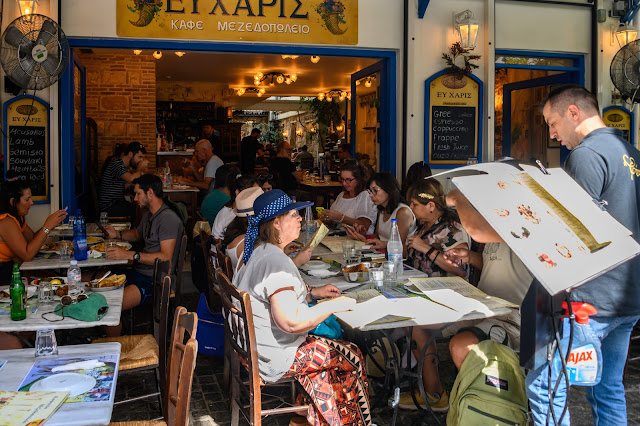Honestly, there is so much to see in Athens, Greece. And like a good "student" I looked up, looked down, looked behind me, and looked ahead.
Prompting me to 📸📸📸.
As we approached Monastiraki neighborhood we could see and feel the anitquity of this area.
"Located under the shadow of the Acropolis, Monastiraki (little monastery) is a unique neighborhood that has been inhabited for six thousand consecutive years! It is among the oldest, most historic and important neighborhoods in Western Culture. The name “Monastiraki” was established during the Greek Revolution against the Ottoman Occupation. It was inspired by the nunnery (female monastery) that was established on the square. The area includes the Ancient Agora, one of the most important archeological sites in Athens, which was the center of the ancient city of Athens."
If one just stands at the center of Monastiraki Square and takes a good look around, one can form a more or less complete picture of Athens’ past and present all within a few square miles. The diversity of the architecture of its buildings characterizes its turbulant history.
"On one side of the square is the Orthodox Church of the Virgin Mary Pantanassa while on the other is the Ottoman-era Mosque of Tzistarakis.
Built in the second century AD, the pillars of Hadrian’s Library can still be seen through the arches of the mosque while, directly above them, the Acropolis dominates your view, forming a stunning backdrop for the scene.
Recently renovated, the square itself is paved with mosaic “flows” of marble, stone, and wrought iron, symbolizing the diversity of the Mediterranean."
An above ground metro was constructed in 1895, the same time that an iconic metro station was built. It was actually a train, not an underground subway, which is why Athenians still call it the “treno.”
The treno connects the Port of Piraeus to Athens and Kifissias, a neighborhood in the north of Athens.
Presently, the underground metro line which connects the airport to the city passes through Monastiraki as well, making it a major transportation hub today.
"In ancient Greek times, the Agora of Athens served as the commercial, social, and political hub of the entire city. An open-air market would be also be held there at certain intervals.
It was the best place for citizens to meet up and debate the future of the city and any of the many other issues of the day.Various temples built to worship the Greek gods surrounded the Agora, which meant that this space also functioned as a vital religious center.
The Stoa of Attalos was located in the Agora area and was a covered patio type building. It was a marketplace with many shops in it, built between 159 to 138 BC as a thank you to Athens from King Attalos of Permagon (an ancient city in Greece). However, the Stoa fell to ruin after being destroyed in 257 AD and after that it was used as a defensive wall. Restoration and rebuilding occurred in the mid 1950’s and now houses the Ancient Agora Museum."
"Monastiraki continued its role as a marketplace in modern Greece as well, with merchants selling their products like fresh fruit, grilled corn, handmade sandals and more, on their street benches."
Today, one of the main attractions is Monastiraki’s Flea Market. This lively bazaar is overflowing with hundreds of stalls that sell from handmade jewelry, relics, carpets, typical souvenirs, clothes and accessories. Also included are street artists playing music as well as visiors sitting relaxed in colorful terraces and restaurants trying some of the best national dishes.
And in case you were wondering, we stopped at "The Greco's Project", right smack in the middle of the square and had some delicious octopus for lunch.
Eventually, it was time to return to the ship. Back on the hop on/hop off created one last chance to take more photos of this populated city.
I am going to leave you with a photo of one of the most iconic locations in Greece; the Acropolis, also known as the Sacred Rock, the symbol of Greece and the Greek culture and the most famous sightseeing in Athens......
..........as we travel off to the next port.

τα λέμε σε (ta léme se) see you in....
Μύκονος











































































Great pictures Camellia. We went to Piraeus a little over 30 years ago (gulp) but I don't recall seeing much of the town. We flew out, did the Acropolis then hopped on a boat for a cruise of the Med so interesting to see more of the place now. As an aside our cruise ship sank off Mauritius some months later😳
ReplyDeleteYikes!!! That's a frightening thought, being on a cruise ship that eventually sank. Were there any passengers on board at the time? It was fun to see the area after so many years, but I decided it wasn't a place I would have liked to live. It just seemed so crowded and unkept. Now Barcelona, is another story....fell in love witht he place. Pictures will come up soon 😉
Delete